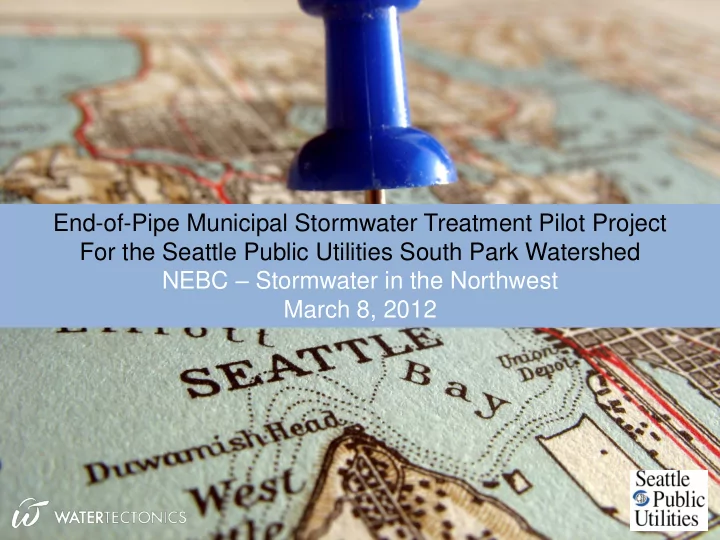

End-of-Pipe Municipal Stormwater Treatment Pilot Project For the Seattle Public Utilities South Park Watershed NEBC – Stormwater in the Northwest Innovative Water Processing Solutions By Water Quality Management Professionals March 8, 2012
1. Meet current permit standard of 80% TSS removal 2. Choose a solution or technology that can be easily modified to accommodate possible future requirements 3. Process effectively at 11 cfs (5,000gpm) 4. Footprint must be 7,000 ft 2 or less 5. Solution must have low long-term O&M cost (volumes could be 150Mgal/year+)
~234 Acre Runoff Area
72” Outfall
• Watershed is located in a heavy-use industrial area; water from street runoff but also sheet flow off many industrial sites • Network of conveyance lines feed 3-4 primary trunk lines which feed a holding vault • Water flows by gravity from vault through 72” outfall pipe via a tide-gate system • Very little elevation difference in the area (top of high tide is roughly top of the road)
SEATTLE PUBLIC UTILITIES WATERTECTONICS GRANITE CONSTRUCTION Sampling & Analysis QAPP Treatment Equipment Site Grading Automated Samplers Consumables Water Detention Tanks Sample Collection Installation Site Logistics Operator Labor
TREATMENT EQUIPMENT WQ CONDITIONS PROCESS CONDITIONS Grit Chamber Turbidity/TSS Sampling Period Electrocoagulation* Conductivity Treatment Flowrate Clarification Media Filtration GAC Filtration *No pre or post pH adjustment: all pH readings were ~7.7-8.1
• Electrons are being introduced into solution (the cathode is oxidized and the water is reduced) • Coagulation is occurring through both ionic bonding (charge) & covalent bonding (electron pairing) • Water (H 2 O) is being cleaved at the cathode • Hydrogen gas induces electro-flotation • Free oxygen increases dissolved oxygen levels • Total and dissolved metals removed through the formation of metal oxides and metal hydroxides • Residual solids is reduced (no long-chain polymers like Chitosan and no counter-ions)
Storm Event Equipment Period Flowrate Avg. NTU In Avg. NTU Out 1.5.12 GC+EC+CL 12hr 200gpm 271 42.5 1.20.12 GC+EC+CL+SF 12hr 200gpm 146.9 15 1.30.12 GC+EC+CL 24hr 200gpm 100.7 28.5 1.31.12 GC+EC+CL+SF+GAC 10hr 200gpm 36.6 3.5 2.28.12 EC+CL+SF+GAC 12hr 200gpm 69.8 4.6 2.29.12 EC+CL+SF+GAC 12hr 200gpm 93 5.4 3.5.12 EC+CL+SF+GAC 7hr 100gpm 237.1 3.9
Units Influent Effluent Total Suspended Solids mg/L 156 33.2 Turbidity NTU 175 35 Fecal coliform cfu/100mL 250 22 Copper, Total µg/L 42.6 10.1 Copper, Dissolved µg/L 4.5 2.3 Lead, Total µg/L 28.5 5 Lead, Dissolved µg/L 0.2 ND < 0.1 Zinc, Total µg/L 163 41 Zinc, Dissolved µg/L 19 8 Diesel Range Hydrocarbons mg/L 0.57 0.19 Motor Oil mg/L 1.6 0.35 Bis(2-ethylhexyl)phthalate µg/L 1.8 ND < 1 Total PCB’s µg/L 0.125 0.015
Turbidity Reduction 700 600 500 400 NTU 300 200 100 0
% Turbidity Removal 100 90 80 70 Percent Removal 60 50 40 30 20 10 0 9:10 10:20 12:00 13:40 14:40 16:30 17:20 18:20
Conductivity 2500 2000 Microsiemens 1500 1000 500 0 9:10 10:20 12:00 13:40 14:40 16:30 17:20 18:20
Units Influent Effluent Total Suspended Solids mg/L 138 13.3 Turbidity NTU 130 14.4 Fecal coliform cfu/100mL 380 23 Copper, Total µg/L 39.1 7 Copper, Dissolved µg/L 5.4 3.4 Lead, Total µg/L 20.3 1.8 Lead, Dissolved µg/L 0.2 ND < 0.1 Zinc, Total µg/L 159 27 Zinc, Dissolved µg/L 39 10 Diesel Range Hydrocarbons mg/L 0.53 0.13 Motor Oil mg/L 1.8 ND < 0.2 Bis(2-ethylhexyl)phthalate µg/L 1.5 ND < 1 Total PCB’s µg/L 0.073 ND <0.01
NTU 100 150 200 250 300 50 0 10:30 10:50 11:10 11:30 11:50 12:20 12:40 13:10 13:30 Turbidity Reduction 13:50 14:00 14:40 15:10 15:40 16:00 16:30 17:10 17:30 17:50 18:10 18:40 19:00 19:20 19:50
100% 120% 20% 40% 60% 80% 0% 10:30 10:50 11:10 11:30 11:50 12:20 12:40 13:10 Turbidity Percent Removal 13:30 13:50 14:00 14:40 15:10 15:40 16:00 16:30 17:10 17:30 17:50 18:10 18:40 19:00 19:20 19:50
Units Influent Effluent Total Suspended Solids mg/L 44.4 32.7 Turbidity NTU 50.7 27 Fecal coliform cfu/100mL - - Copper, Total µg/L 18.7 8.7 Copper, Dissolved µg/L 4.4 2 Lead, Total µg/L 11.2 4.1 Lead, Dissolved µg/L 0.6 ND < 0.1 Zinc, Total µg/L 86 42 Zinc, Dissolved µg/L 28 4 Diesel Range Hydrocarbons mg/L 0.23 0.12 Motor Oil mg/L 0.63 0.23 Bis(2-ethylhexyl)phthalate µg/L ND < 1 ND < 1 Total PCB’s µg/L 0.032 0.012
NTU 100.0 120.0 140.0 160.0 180.0 200.0 20.0 40.0 60.0 80.0 0.0 2:00 2:30 3:00 3:30 4:00 4:30 5:00 Turbidity Reduction 5:30 6:00 6:30 7:00 7:30 9:20 11:00 11:30 12:00 12:40 18:10 19:00 19:50 20:10 21:30 22:20
100% 10% 20% 30% 40% 50% 60% 70% 80% 90% 0% 2:00 2:30 3:00 3:30 4:00 4:30 5:00 5:30 Percent Removal 6:00 6:30 7:00 7:30 9:20 11:00 11:30 12:00 12:40 18:10 19:00 19:50 20:10 21:30 22:20
• One of the first times we’ve analyzed electrocoagulation treatment on a large-scale without doing sand filtration • In removing the sand filtration step, it allowed us to see that the relationship between metals removal and turbidity/TSS reduction was not direct • In fact, it appears that the turbidity/TSS flocculated particles that were associated with the heavy metal/PCB content settled out disproportionately faster than other turbidity/TSS fractions, maybe due to molecular weight, polarity, particle charge, etc.
• Analytical data from last four storm events is still forthcoming • Interested to see how adjusting clarification time and adding carbon filtration affect treatment • Off-the-shelf weir tanks were used for clarification on the project; additional effort is needed to design a high-efficiency clarification system; data collected from the pilot should be useful in accomplishing this
• Key advantage is that solids are removed from the flow of water and not building up on filters • Mechanical separation processes AND chemical reactions that improve and speed up treatment • In passive filtration systems, you can get build-up of organic matter which promotes bacterial growth, which forms bio-films and sub-micron particles that work their way into filter beds and blind them
WaterTectonics 6300 Merrill Creek Parkway Suite C-100 Everett, WA 98203 www.watertectonics.com
Recommend
More recommend